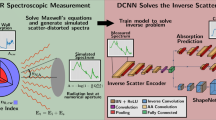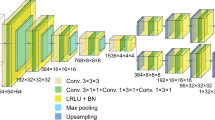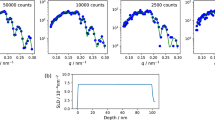Abstract
Nano-structured thin films have a variety of applications from waveguides, gaseous sensors to piezoelectric devices. Grazing Incidence Small Angle x-ray Scattering images enable classification of such materials. One challenge is to determine structure information from scattering patterns alone. This paper highlights the design of multiple Convolutional Neural Networks (CNN) to classify nanoparticle orientation in a thin film by learning scattering patterns. The network was trained on several thin films with a success rate of 94%. We demonstrate CNN robustness under different noises as well as demonstrate the potential of our proposed approach as a strategy to decrease scattering pattern analysis time.









Similar content being viewed by others
References
A. Dong, J. Chen, P.M. Vora, J.M. Kikkawa, and C.B. Murray: Binary nanocrystal superlattice membrane self-assembled at the liquid-air interface. Nature 466 474 (2010).
G. Renaud, R. Lazzari, and F. Leroy: Probing surface and interface morphology with Grazing Incidence Small Angle X-Ray Scattering. Surf. Sci. Rep. 64, 255–380 (2009).
A. Hexemer and P. Müller-Buschbaum: Advanced grazing-incidence techniques for modern soft-matter materials analysis. IUCrJ 2, 106–125 (2015).
T.E. Williams, D. Ushizima, C. Zhu, A. Anders, D.J. Milliron, and B.A. Helms: Nearest-neighbor nanocrystal bonding dictates framework stability or collapse in colloidal nanocrystal frameworks. Chem. Commun. 53, 4853–4856 (2017).
D. Smilgies: GISAXS–Grazing-Incidence Small-Angle Scattering. The SAXS Guide, 4th ed. (Anton Paar GmbH., Austria, 2017), pp. 109–123.
G.H. Vineyard: Grazing-incidence diffraction and the distorted-wave approximation for the study of surfaces. Phys. Rev. B 26, 4146–4159 (1982).
S.K. Sinha, E.B. Sirota, S. Garoff, and H.B. Stanley: X-ray and neutron scattering from rough surfaces. Phys. Rev. B 38, 2297–2311 (1988).
H. Deyhle, S.N. White, L. Botta, M. Liebi, M. Guizar-Sicairos, O. Bunk, and B. Müller: Automated analysis of spatially resolved x-ray scattering and micro computed tomography of artificial and natural enamel carious lesions. J. Imaging 4, 81 (2018).
C. E. Rasmussen: Gaussian processes in machine learning Advanced lectures in machine learning (Springer 2014) pp. 63–71.
J. Snoek, H. Larochelle, and R.P. Adams: Practical Bayesian optimization of machine learning algorithms. Adv. Neural. Inf. Process. Syst. (25), 2951–2959 (2012).
Y. LeCun, L. Bottou, Y. Bengio, and P. Haffner: Gradient-based learning applied to document recognition. Proc. IEEE 86, 2278–2324 (1998).
A. Krizhevsky, I. Sutskever, and G.E. Hinton: ImageNet classification with deep convolutional neural networks. Adv. Neural Inf. Process. Syst. 25, 1097–1105 (2012).
F.H.D. Araujo, R.R.V. Silva, F.N.S. Medeiros, D.D. Parkinson, A. Hexemer, C.M. Carneiro, and D.M. Ushizima: Reverse image search for scientific data within and beyond the visible spectrum. Expert Syst. Appl. 109, 35–48 (2018).
J. Ling, M. Hutchinson, E. Antono, B. DeCost, E.A Holm, and B. Meredig: Building data-driven models with microstructure images: generalization and interpretability. Mater. Discov. 10, 19–28 (2017).
D.M. Pelt and J.A. Sethian: A mixed-scale dense convolutional neural network for image analysis. Proc. Natl. Acad. Sci. USA 115, 254–259 (2018).
A. Oliynik, E. Antono, T. Sparks, L. Ghadbeigi, M. Gaultois, B. Meredig, and A. Mar: High-throughput machine-learning-driven synthesis of fullheusler compounds. Chem. Mater. 28, 7324–7331 (2016).
C. Douarre, R. Schielein, C. Frindel, S. Gerth, and D. Rousseau: Transfer learning from synthetic data applied to soil-root segmentation in x-ray tomography images. J. Imaging 4, 65 (2018).
M.H. Kiapour, K. Yager, A.C. Berg, and T.L. Berg: Materials discovery: fine-grained classification of x-ray scattering images. IEEE Winter Conference on Applications of Computer Vision, 933–940 (2014).
B. Wang, K. Yager, D. Yu, and M. Hoai: X-ray scattering image classification using deep learning. IEEE Winter Conference on Applications of Computer Vision (WACV), 697–704 (2017).
Y. Li, W. Cheng, L.H. Yu, and R. Rainer: Genetic algorithm enhanced by machine learning in dynamic aperture optimization. Phys. Rev. Accel. Beams 21, 054601 (2018).
D. Rossou, P. Burdet, F. de la Peña, C. Ducati, B. Knappett, A. Edward Henry Wheatley, and P. Anthony Midgley: Multicomponent signal unmixing from nanoheterostructures: overcome the traditional challenges of nanoscale x-ray analysis via machine learning. Nanoletters 15(4), 2716–2720 (2015).
N. Laanait, Z. Zhang, and C.M. Schlepütz: Imaging nanoscale lattice variations by machine learning of x-ray diffraction microscopy data. Nanotechnology 27, 374002 (2016).
J. Timoshenko, D. Lu, Y. Lin, and A.I. Frenkel: Supervised machine-learning-based determination of three-dimensional structure of metallic nanoparticles. J. Phys. Chem. Lett. 8, 5091–5098 (2017).
S.T. Chourou, A. Sarje, X.S. Li, E.R. Chan, and A. Hexemer: HipGISAXS: a highperformance computing code for simulating grazing-incidence x-ray scattering data. J. Appl. Crystallogr. 46, 1781–1795 (2013). https://www.hipgisaxs.github.io/.
I. Goodfellow, Y. Bengio, and A. Courville: Deep Learning (MIT Press, Cambridge, MA, 2016), pp. 173–174.
N.M Nasrabadi: Pattern recognition and machine learning. J. Electron. Imaging 16, 049901 (2007).
K. Simonyan and A. Zisserman: Very deep convolutional networks for large-scale image recognition. The International Conference on Learning Representations (ICLR), 1–14 (2015).
K. He, X. Zhang, S. Ren, and J. Sun: Deep residual learning for image recognition. The IEEE Conference on Computer Vision and Pattern Recognition (CVPR), 770–778 (2016).
S. Wold, K. Esbensen, and P. Geladi: Principal component analysis. Chemom. Intell. Lab. Syst. 2, 37–52 (1987).
X. Ye, C. Zhu, P. Ercius, S.N. Raja, B. He, M.R. Jones, M.R. Hauwiller, Y. Liu, T. Xu, and P. Alivisatos: Structural diversity in binary superlattices self-assembled from polymer-grafter nanocrystals. Nature 6, 1–10 (2015).
Acknowledgments
The authors acknowledge authors Ye, Zhu, Ercius, Raja, He, Jones, Hauwiller, Liu, Xu, and Alivisatos for allowing us to use their data for our real experiment analysis. This work was supported by the Center of Advanced Mathematics for Energy Research Applications (CAMERA) through the Office of Science, of the US Department of Energy under Contract No. DE-AC02-05CH11231 and the Early Career Program. This research is funded in part by the Gordon and Betty Moore Foundation through Grant GBMF3834 and by the Alfred P. Sloan Foundation through Grant 2013-10-27 to the University of California, Berkeley. This research used resources of the National Energy Research Scientific Computing Center (NERSC), a US Department of Energy Office of Science User Facility operated under Contract No. DE-AC02-05CH11231.
Author information
Authors and Affiliations
Corresponding author
Supplementary Material
Supplementary Material
The supplementary material for this article can be found at https://doi.org/10.1557/mrc.2019.26
Rights and permissions
About this article
Cite this article
Liu, S., Melton, C.N., Venkatakrishnan, S. et al. Convolutional neural networks for grazing incidence x-ray scattering patterns: thin film structure identification. MRS Communications 9, 586–592 (2019). https://doi.org/10.1557/mrc.2019.26
Received:
Accepted:
Published:
Issue Date:
DOI: https://doi.org/10.1557/mrc.2019.26




